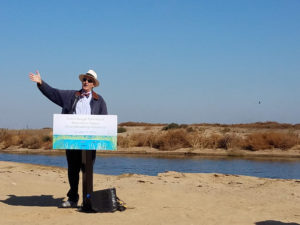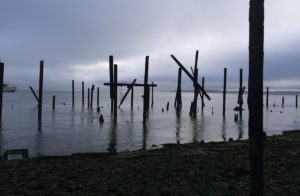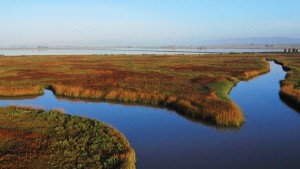Amy Hutzel developed her passion for wetlands and estuaries in the Bay Area while completing an environmental education internship at the Don Edwards San Francisco Bay National Wildlife Refuge in Alviso. That was in 1992. Then in 2000, Amy accepted a position at the state Coastal Conservancy as a project manager working on the Napa-Sonoma Marsh Restoration Project and then the South Bay Salt Ponds Restoration Project. In 2006, she became the Conservancy’s Bay Area Program Manager. In this capacity, she manages a staff of ten people doing habitat restoration, land protection, and public access projects throughout the nine-county Bay Area.
BN: What’s your favorite place to go in the Bay Area?
AH: Now that I have two little ones, the beach is my favorite place. When it’s sunny, we travel to Pacifica State Beach – it’s such a short drive from home. Also, we’ve been taking the kids camping at Butano State Park for the past few years – I love being able to camp in the redwoods, spend the day at the nearby beach, and slip in a little goat-cheese-tasting and berry-picking near Pescadero.
BN: What can you tell us about the restoration projects going on in and around San Francisco Bay?
AH: The massive wetland restoration being planned and implemented in San Francisco Bay is a renaissance for the Bay, with huge benefits for the wildlife and the people of the Bay Area – from habitat for endangered species like clapper rails and salt marsh harvest mice, to carbon sequestration and improved flood management. Nearly 40,000 acres of diked baylands have been acquired over the past couple of decades and multiple agencies and organizations are working to enhance or restore these lands.
The majority of the people around the Bay Area support wetland restoration and are willing to back that up with funding. Over the next couple of decades, the wetlands will need all the support they can get! After all, restoration isn’t a simple matter of breaching levees and letting the tides back in – oftentimes the lands are subsided, requiring the use of sediment to raise the elevation of the site and levees. This process also protects development on the land side of the restoration projects. But these projects are not cheap or easy to complete; they require a lot of coordination and funding.
BN : What would be a good way for people to see some of the results of this restoration work?
AH: If you live in the North Bay, I suggest a hike at Sonoma Baylands – it was restored in the 1990s using dredged material from the Port of Oakland, and ever since, it’s been evolving into vegetated tidal marsh. Fall and spring are good times to see shorebirds there; try to time your visit with the tides – as the tide rises over the mudflats in the bay, shorebirds head to Sonoma Baylands, which eventually also gets covered with water.
To see a wetland restoration project in an urban setting, you can visit Crissy Field.
In the South Bay, LaRiviere Marsh at the entrance to the Don Edwards San Francisco Bay National Wildlife Refuge in Fremont is fantastic. It was restored in the 1980s and looks so great you would think it was historic marsh. There is a boardwalk trail through the marsh and the Refuge’s new Visitor Center sits right next to the marsh.
On the Peninsula side of the Bay is Pond SF2, which lies at the foot of the Dumbarton Bridge. This former salt pond has just been enhanced to provide habitat for shorebirds and waterfowl. The trail along the levee, with its viewing platforms, provides many opportunities to watch the birds using the pond. This winter will be the first test of the pond’s ability to attract shorebirds and waterfowl in large numbers – go check it out!
BN: What are some good ways to get kids interested in restoration?
AH: I had the opportunity to work on the Common Murre Restoration Project on Devil’s Slide Rock over ten years ago, when I ran the education component of this project. Part of my job involved talking to kids from classrooms in Pacifica and Half Moon Bay. I learned a few things: 1) Kids love to paint common murre decoys, and they love the idea that a decoy they painted will be placed on a small rock island off the coast to lure in the real murres, 2) Murre eggs are pointed, which means that they roll in circles instead of off the cliffs, and 3) People desperately want to play a part in meaningful efforts to restore and connect to their local environment.
BN: What do you like most about living in the Bay Area?
AH: I love living in an urban, walkable, transit-oriented city but having easy access to open space, either for camping or day use. I also love the weather!

.jpg)



